MaryAnn Bernal's Blog, page 172
June 8, 2015
History Trivia - Vikings raid the abbey at Lindisfarne
June 8,
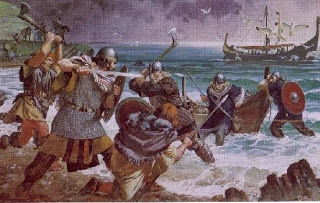
793 Vikings raid the abbey at Lindisfarne in Northumbria, and is commonly accepted as the beginning of the Scandinavian invasion of England.
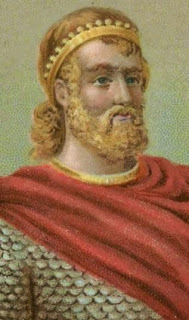
1042 Harthacanute, King of Denmark and England died.
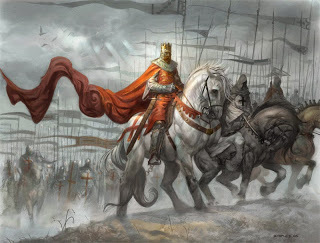
1191 Richard the Lion-Hearted of England arrived at the port of Acre in the Holy Land during the third Crusade. He captured Acre, but could not recapture Jerusalem from the Turks.

793 Vikings raid the abbey at Lindisfarne in Northumbria, and is commonly accepted as the beginning of the Scandinavian invasion of England.

1042 Harthacanute, King of Denmark and England died.

1191 Richard the Lion-Hearted of England arrived at the port of Acre in the Holy Land during the third Crusade. He captured Acre, but could not recapture Jerusalem from the Turks.
Published on June 08, 2015 02:00
June 7, 2015
History Trivia - Rotterdam Netherlands founded
June 7,
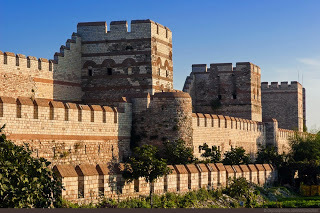
421 Eudocia Athenais married Byzantine Emperor Theodosius II who constructed a series of defensive walls that surrounded and protected the city of Constantinople.
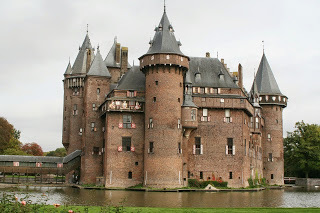
1340 Rotterdam Netherlands founded.
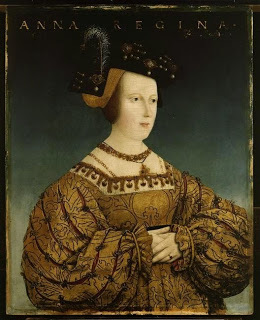
1394 Anne of Bohemia, wife of Richard II of England died from plague.

421 Eudocia Athenais married Byzantine Emperor Theodosius II who constructed a series of defensive walls that surrounded and protected the city of Constantinople.

1340 Rotterdam Netherlands founded.

1394 Anne of Bohemia, wife of Richard II of England died from plague.
Published on June 07, 2015 02:30
June 6, 2015
History Trivia - The Ashmolean Museum in Oxford, England opens
June 6
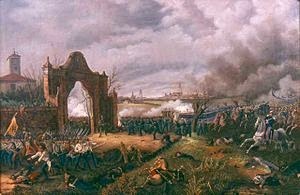
1513 Italian Wars: Battle of Novara. Swiss troops defeated the French under Louis de la Tremoille, forcing the French to abandon Milan. Duke Massimiliano Sforza was restored.
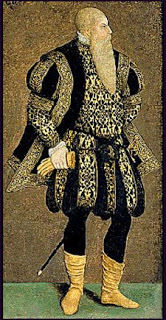
1523 Gustav Vasa was elected King of Sweden, marking the end of the Kalmar Union, which had united the three kingdoms of Denmark, Norway (with Iceland, Greenland, Faroe Islands, Shetland, and Orkney),and Sweden.
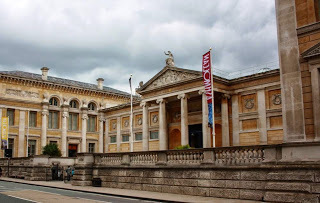
1683 The Ashmolean Museum in Oxford, England, opened as the world's first university museum.

1513 Italian Wars: Battle of Novara. Swiss troops defeated the French under Louis de la Tremoille, forcing the French to abandon Milan. Duke Massimiliano Sforza was restored.

1523 Gustav Vasa was elected King of Sweden, marking the end of the Kalmar Union, which had united the three kingdoms of Denmark, Norway (with Iceland, Greenland, Faroe Islands, Shetland, and Orkney),and Sweden.

1683 The Ashmolean Museum in Oxford, England, opened as the world's first university museum.
Published on June 06, 2015 02:30
June 5, 2015
Audio Book Launch - Scribbler Tales Volume Four

Written by: Mary Ann Bernal Narrated by: Roberto Scarlato Length: 1 hr and 12 mins
When the daughter of a wealthy entrepreneur is kidnapped, Agent Richards races against time to find her in "Abducted".In "Cunning", newlywed Charlotte von Lichtner, who is obsessed with Transylvanian folklore, encounters her husband's mysterious kinsman. "Enamored" finds Lady Margaret besotted and in an unorthodox relationship with a younger man, whose intentions are suspect. Will the murderer succeed as he flees the crime scene in "Reckless"? Doctor/patient confidentiality is sorely tested when Sarah reveals the truth about her lover's death in "Safeguard".
Amazon link
Audible Link
Published on June 05, 2015 15:09
Two thousand year old Mercury figurine found in Yorkshire
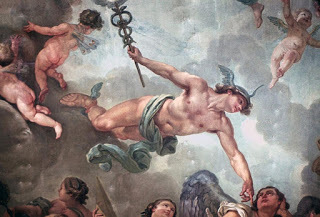 Ancient Origins
Ancient OriginsA metal detector enthusiast has discovered a 2000-year old figurine depicting the Roman god Mercury in a field near Selby, Yorkshire, UK.
It is the 1,000th officially recorded archaeological find of the year so far in Yorkshire. The artifact was registered by Dave Cooper of the York and District Metal Detecting Club on May 15th, ironically the date of the Roman festival that once honored the god himself.
Rebecca Griffiths, the Finds Liaison Officer for the Portable Antiquities Scheme at the York Museums Trust told Culture24 said that the registration of the artifact on the day of the ancient Mercuralia was “pure coincidence – but a very happy one.”
 Rebecca Griffiths of York Museums Trust with the copper alloy figurine of Mercury. Photographs: Richard McDougallThe Mercuralia, or ‘Festival of Mercury’ honoured the Roman god of messengers, who was known as Hermes to the Greeks. There are separate Roman myths concerning Mercury which do not have any equivalents in Greek myth, however in both cultures the god was believed to be a god of traders and commerce. The Roman name ‘Mercury’ is related to the latin words merx, mercari and merces, meaning merchandise, trade and wages respectively. May 15th was also believed to be Mercury’s birthday, also called the ‘Ides of May’. Merchants in Rome celebrated the festival by sprinkling their merchandise, ships and their heads with water from a fountain at Porta Capena called the ‘aqua Mercurii’. They carried the water in laurel boughs and prayed to the god for forgiveness, profit and the ability to cheat on customers.
Rebecca Griffiths of York Museums Trust with the copper alloy figurine of Mercury. Photographs: Richard McDougallThe Mercuralia, or ‘Festival of Mercury’ honoured the Roman god of messengers, who was known as Hermes to the Greeks. There are separate Roman myths concerning Mercury which do not have any equivalents in Greek myth, however in both cultures the god was believed to be a god of traders and commerce. The Roman name ‘Mercury’ is related to the latin words merx, mercari and merces, meaning merchandise, trade and wages respectively. May 15th was also believed to be Mercury’s birthday, also called the ‘Ides of May’. Merchants in Rome celebrated the festival by sprinkling their merchandise, ships and their heads with water from a fountain at Porta Capena called the ‘aqua Mercurii’. They carried the water in laurel boughs and prayed to the god for forgiveness, profit and the ability to cheat on customers.The translation of the Gallic faith into the Roman pantheon The Celtic Goddess Epona that Rode Swiftly Across the Ancient Roman Empire Ancient Roman Curse Tablets Invoke Goddess Sulis Minerva to Kill and Maim The Porta Capena was a gateway in the Servian Wall on the south side of Rome. Its stones were supposed to have been stained green by water leaking from the Aqua Marcia aqueduct that towered above it. Samuel Ball Platner mentions the fountain in his 1911 book The Topography and Monuments of Ancient Rome in which he writes:
Aqua Mercurii…a spring which is thought to be one of those now flowing in the gardens of the villa Mattei Its waters were conducted in an artificial channel through the valley of the Circus Maximus to the Cloaca Maxima
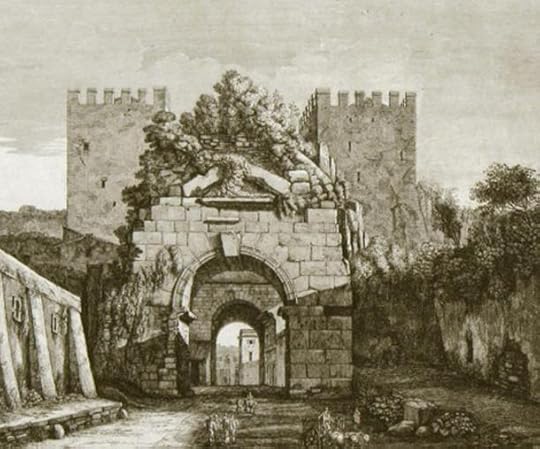 The Porta Carpena, Rome. Copperplate engraving by Luigi Rossini (oldimprints.com)According to Rome: An Oxford Archaeological Guide by Amanda Claridge, Judith Toms and Tony Cubberley, the source of the aqua Mercurii was a small wood in which there was a sacred grove dedicated to the goddess Egeria. Mercury himself was venerated in a temple on the Aventine Hill. Although he is usually depicted as wearing a winged cap or winged sandals and carrying a caduceus, attributes borrowed from Hermes, he is also represented as carrying a purse, the symbol of the merchants he protected.
The Porta Carpena, Rome. Copperplate engraving by Luigi Rossini (oldimprints.com)According to Rome: An Oxford Archaeological Guide by Amanda Claridge, Judith Toms and Tony Cubberley, the source of the aqua Mercurii was a small wood in which there was a sacred grove dedicated to the goddess Egeria. Mercury himself was venerated in a temple on the Aventine Hill. Although he is usually depicted as wearing a winged cap or winged sandals and carrying a caduceus, attributes borrowed from Hermes, he is also represented as carrying a purse, the symbol of the merchants he protected. Statue of Mercury by Charles Meynier. Mercury is depicted wearing a winged cap and is carrying the caduceus in one hand and a purse in the other. (
Wikimedia Commons
)Mercury’s Greek counterpart, Hermes, was believed to be the son of Zeus, the king of the gods, and his queen, Maia. He was believed to be swift on his feet, thereby being able to move quickly between the worlds of gods and men. Both Hermes and Mercury were believed to be protectors of thieves and athletes, as well as of merchants. Hermes also performed the role of escorting the souls of the dying to the underworld and the afterlife. The Greeks believed that when Hermes was young, he jumped from his crib and went off to steal the cattle kept by the sun-god, Apollo, who appeared before Zeus and complained. However, Zeus simply laughed in his face. Hermes apologised to Apollo by giving him the lyre he had just made.
Statue of Mercury by Charles Meynier. Mercury is depicted wearing a winged cap and is carrying the caduceus in one hand and a purse in the other. (
Wikimedia Commons
)Mercury’s Greek counterpart, Hermes, was believed to be the son of Zeus, the king of the gods, and his queen, Maia. He was believed to be swift on his feet, thereby being able to move quickly between the worlds of gods and men. Both Hermes and Mercury were believed to be protectors of thieves and athletes, as well as of merchants. Hermes also performed the role of escorting the souls of the dying to the underworld and the afterlife. The Greeks believed that when Hermes was young, he jumped from his crib and went off to steal the cattle kept by the sun-god, Apollo, who appeared before Zeus and complained. However, Zeus simply laughed in his face. Hermes apologised to Apollo by giving him the lyre he had just made.Hermes appears in a number of Greek myths, including that of the hero Odysseus, the Odyssey. Hermes commanded the hero to chew the leaves of a magic herb so that he could avoid the gaze of Circe which had turned Odysseus’s companions into animals. The god also appears in the story of Pandora in which he gave her the ability to lie and seduce men.
 Hermes / Mercury carrying away Pandora by Jean Alaux (
Wikimedia Commons
)The Mercury figurine found in Yorkshire is made of copper alloy. Although it depicts the god wearing a cap, this garment has lost its famous wings. It is just one of many similar figures that have been found across the UK, according to the Yorkshire Post.
Hermes / Mercury carrying away Pandora by Jean Alaux (
Wikimedia Commons
)The Mercury figurine found in Yorkshire is made of copper alloy. Although it depicts the god wearing a cap, this garment has lost its famous wings. It is just one of many similar figures that have been found across the UK, according to the Yorkshire Post.The York Museums Trust regularly receives artifacts found by the general public. Such items have previously included the Bedale Hoard, the Escrick Ring and the boar badge of Richard III.
“Every year thousands of archaeological objects are discovered,” says Rebecca Griffiths. “While the majority of these come from metal-detector users, we also see many finds from people field-walking, gardening, renovating houses and even those out walking particularly inquisitive dogs.”
Ms Griffiths added that every year, she and her team of volunteers add more than 2,000 items to the museum’s collection, ranging from Roman coins to medieval buckles, to stone tools and post-medieval toys.
Featured image: ‘The Elevation of the Great Elector into Olympus’. Ceiling painting (detail: Mercury), City Palace, Potsdam ( Wikimedia Commons ).
Published on June 05, 2015 06:24
History Trivia - The Battle of New Ross
June 5
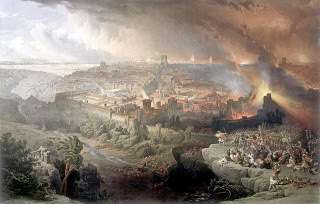
70 Titus and his Roman legions breached the middle wall of Jerusalem in the Siege of Jerusalem.
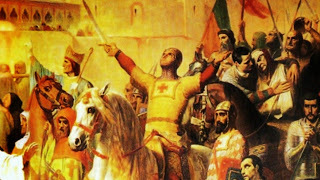
1099 Members of the First Crusade witnessed an eclipse of the moon and interpreted it as a sign they would recapture Jerusalem.
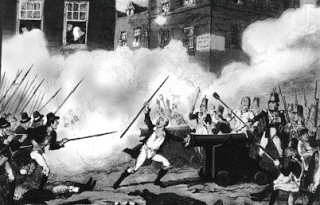
1798 The Battle of New Ross: The attempt to spread United Irish Rebellion into Munster was defeated.

70 Titus and his Roman legions breached the middle wall of Jerusalem in the Siege of Jerusalem.

1099 Members of the First Crusade witnessed an eclipse of the moon and interpreted it as a sign they would recapture Jerusalem.

1798 The Battle of New Ross: The attempt to spread United Irish Rebellion into Munster was defeated.
Published on June 05, 2015 02:30
June 4, 2015
Viking beaters: Scots and Irish may have settled Iceland a century before Norsemen
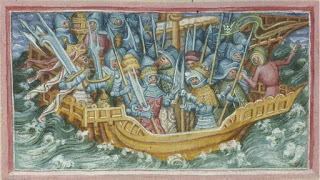 Ancient Origins
Ancient OriginsRemarkably similar carvings and simple cross sculptures mark special sites or places once sacred, spanning a zone stretching from the Irish and Scottish coasts to Iceland. We can look to Skellig Michael, which rises from the sea 12km off the southwest Irish coast; to Aird a’Mhòrain on the Outer Hebridean island of North Uist; to the Isle of Noss, Shetland; and to Heimaklettur cliff face in Iceland’s Westman Islands.
Also in southern Iceland, a number of the 200 man-made caves found there are marked by similar rock-cut sculpture. And these dark remote places suggest a different answer to a puzzle that we thought we had solved a long time ago.
Iceland was one of the last island groups on Earth to be settled by people. As you might expect, the late-ninth-century settlement by Viking-Age Scandinavians has long been of keen interest to the local people. These artificial caves suggest that we should re-think our traditional histories. The Viking arrival may indeed have been pre-dated by Celtic-speaking people from Scotland and Ireland in around AD 800.
Crosses mark the spot
 Iceland cross carving. Credit: Kristján AhronsonOur search for answers to these questions took
Dr Tõnno Jonuks
and myself to the Westman Islands, which lie a few kilometres south west of the Icelandic mainland. We found our way up the Heimaklettur cliff on Heimaey, the largest of the islands, on the hunt for one of these enigmatic cross sculptures.
Iceland cross carving. Credit: Kristján AhronsonOur search for answers to these questions took
Dr Tõnno Jonuks
and myself to the Westman Islands, which lie a few kilometres south west of the Icelandic mainland. We found our way up the Heimaklettur cliff on Heimaey, the largest of the islands, on the hunt for one of these enigmatic cross sculptures.And we found what we were looking for: a large cross carved into a small alcove on the otherwise exposed cliff face – similar to other rock-cut crosses in some of the 200 artificial caves clustered around farms in southern Iceland. Then to our surprise, two more crosses, along a high ledge overlooking the harbour and the bustling fishing town of Heimaey – all of them key exhibits towards the team’s imminent discoveries.
Did a Native American travel with the Vikings and arrive in Iceland centuries before Columbus set sail? Vikings in Byzantium: The Varangians and their Fearless Conquests New study shows Viking women accompanied men on voyages to colonize far-flung lands
 Isle of Heimaey.
Thomas Quine
,
CC BY-SA
These contributed to
research focused
on Seljaland, which is nearby on the mainland and now appears to be Iceland’s earliest dated settlement, at around AD 800. What we were also able to reveal was that the 24 large cross sculptures inside the Seljaland caves (and also found elsewhere in southern Iceland) are related to early medieval sculpture in Britain and Ireland.
Isle of Heimaey.
Thomas Quine
,
CC BY-SA
These contributed to
research focused
on Seljaland, which is nearby on the mainland and now appears to be Iceland’s earliest dated settlement, at around AD 800. What we were also able to reveal was that the 24 large cross sculptures inside the Seljaland caves (and also found elsewhere in southern Iceland) are related to early medieval sculpture in Britain and Ireland.Islands off the west coast of Scotland have long been known as a core area for the early medieval monastic communities that produced these simple cross sculptures - and each sculpture is thought to result from an impulse of religious devotion. What has been unclear is the nature and extent of their settlements beyond the Gaelic-speaking world.
The flowering of Gaelic monasticism is well established for the early medieval period, with individuals and monastic foundations of the “Irish school” penetrating large areas of Europe and accounts of north Atlantic travels and settlements. So too is the religious impulse to seek a “desert” or wilderness in the ocean. But we had been left wondering whether this impulse took these communities to Iceland before the Old Norse-speaking Vikings that later came to dominate this Atlantic zone.
How we made our discoveryWorking with world-leading Edinburgh illustrators and analysts Ian G Scott and Ian Fisher, we found striking stylistic similarities in Iceland with the early medieval sculpture of the western Highlands and islands of Scotland. This area includes the important monastery of Iona in Argyll, as well as extreme locales for Scotland’s early Christian communities, such as at St Molaise’s Cave on Holy Isle (off Arran in the Firth of Clyde) and at isolated north Atlantic places such as the tiny island of North Rona (north of Lewis).
 Map of Iceland showing the location of Seljaland in the South. (
Google Maps
)Seljaland’s caves are remarkable in their own right for their concentration of sculpture and because they have been dug out of the rock, forming part of a poorly understood yet distinctively Icelandic phenomenon. We were able to accurately date one of these caves by finding construction waste from where it had been excavated from the Icelandic rock. Myself and
Dr Kate Smith
of Exeter University related this waste material to layers of volcanic airfall, ash layers that
have been
dated by international teams of researchers with remarkable precision and are a powerful dating tool for this part of the world. And we developed new methods to study the surface of volcanic ash layers that helped us to better understand the processes by which people cleared and managed that woodland, and contributed to creating the pastoral landscape that we recognise today. Again, these human activities can be accurately dated and chime with the our other lines of investigation.
Map of Iceland showing the location of Seljaland in the South. (
Google Maps
)Seljaland’s caves are remarkable in their own right for their concentration of sculpture and because they have been dug out of the rock, forming part of a poorly understood yet distinctively Icelandic phenomenon. We were able to accurately date one of these caves by finding construction waste from where it had been excavated from the Icelandic rock. Myself and
Dr Kate Smith
of Exeter University related this waste material to layers of volcanic airfall, ash layers that
have been
dated by international teams of researchers with remarkable precision and are a powerful dating tool for this part of the world. And we developed new methods to study the surface of volcanic ash layers that helped us to better understand the processes by which people cleared and managed that woodland, and contributed to creating the pastoral landscape that we recognise today. Again, these human activities can be accurately dated and chime with the our other lines of investigation. Seljalandshellar cave in the Westman Islands. Credit: Kristjan AhronsonWhat must it have been like, to undertake Atlantic journeys to this wild northern island with its coastal woodland? Were early travels inspired by observing migratory bird routes from Scotland and Ireland, which nowadays include those of the barnacle goose and pink-footed goose?
Seljalandshellar cave in the Westman Islands. Credit: Kristjan AhronsonWhat must it have been like, to undertake Atlantic journeys to this wild northern island with its coastal woodland? Were early travels inspired by observing migratory bird routes from Scotland and Ireland, which nowadays include those of the barnacle goose and pink-footed goose?What were the challenges for early life, and how and when did people set about transforming the forested landscape into the grasslands needed for sheep, goats, pigs, cattle and horses? Were pigs especially useful for clearing woodland, or perhaps fire? Did pioneer-life present special opportunities, and how did this relate to life back home? And finally, how did this early phase relate to the large-scale Scandinavian Viking settlement that followed 100 years later? These are just some of the questions to be answered now that we can say that Iceland’s human habitation story is not quite what we previously believed.
Featured image: Excerpt from folio 47v of Harley MS 2278. The scene depicts Hinguar and Hubba setting out to avenge their father, Lothbrok. ( Wikimedia Commons )
The article ‘Viking beaters: Scots and Irish may have settled Iceland a century before Norsemen’ was originally published on The Conversation and has been republished under a Creative Commons license.
Published on June 04, 2015 06:26
History Trivia - process of making Roquefort cheese discovered
June 4

781 BC – The first historic solar eclipse was recorded in China.
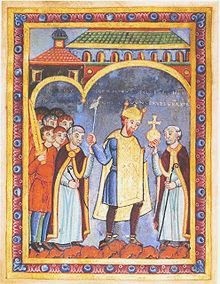
1039 Henry III became Holy Roman Emperor.

1070 the process of making Roquefort cheese was discovered by an anonymous shepherd in a cave near Roquefort, France.

781 BC – The first historic solar eclipse was recorded in China.

1039 Henry III became Holy Roman Emperor.

1070 the process of making Roquefort cheese was discovered by an anonymous shepherd in a cave near Roquefort, France.
Published on June 04, 2015 02:30
June 3, 2015
Did Roman Britain have its own emperor?
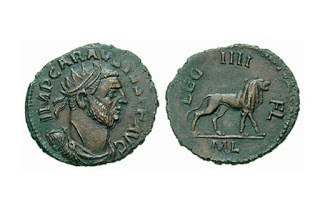 Carausius coin with his face on one side and lion on the reverse | © Panairjdde History Extra Roman Emperors spent centuries trying to get a foothold in Britain, and keep hold of it, but one man tried a different approach to gain power.
Carausius coin with his face on one side and lion on the reverse | © Panairjdde History Extra Roman Emperors spent centuries trying to get a foothold in Britain, and keep hold of it, but one man tried a different approach to gain power.In AD 286, Rome issued orders for the execution of one of their naval commanders, a man called Carausius who had been tasked with clearing the Channel of pirates but who was suspected of collaborating with them in order to line his own pockets.
Carausius got wind of this and responded by declaring himself Emperor of Britain and northern Gaul (France).
To pay his forces and promote his rule Carausius minted thousands of coins. Many of these have been uncovered in archaeological excavations and depict a thick-set bruiser of a man with a beard and a double chin.
Many of what we now call the ‘Forts of the Saxon Shore’ – Roman forts like Pevensey or Portchester - may have been built or at least strengthened by Carausius, not to keep out Saxon raiders but to defend his independent empire.
In AD 293, Carausius was assassinated by Allectus, his finance minister. Allectus ruled for three years until Rome mounted an invasion, defeated and killed him and Britain’s brief independent empire came to an end.
Answered by one of our Q&A experts, Julian Humphrys. For more fascinating questions by Julian, and the rest of our panel, pick up a copy of History Revealed! Available in print and for digital devices.
Published on June 03, 2015 07:54
Da Vinci Discovered: Art Sleuthing Reveals Leonardo Engraving
Live Science
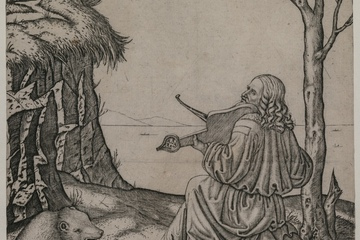
 This engraving, created by Marcantonio Raimondi around 1505, may show Leonardo da Vinci playing an instrument called a lira da braccio. The man in the engraving was thought to be Orpheus, a musician in Greek mythology.
This engraving, created by Marcantonio Raimondi around 1505, may show Leonardo da Vinci playing an instrument called a lira da braccio. The man in the engraving was thought to be Orpheus, a musician in Greek mythology.
Credit: Image courtesy Cleveland Museum of Art, 21.4 x 17.3 cm. Dudley P. Allen Fund 1930.579 View full size image
1930.579 View full size image
A 500-year-old engraving may show Leonardo da Vinci playing a musical instrument called a lira da braccio. If verified, the engraving would represent just the third contemporary depiction of da Vinci (created while he was alive) still in existence.
An artist named Marcantonio Raimondi created the engraving in 1505. But only recently did Ross Duffin, a music professor at Case Western Reserve University in Cleveland, identify the man in the engraving as Leonardo da Vinci, publishing the findings in the magazine Cleveland Art.
Cleveland Art.
"This is serious and stands some chance of being right," said Martin Kemp, an emeritus professor of art history at Oxford University who has written extensively about da Vinci, but who was not involved in the new research. [5 Surprising Facts About Leonardo da Vinci's Life]
Is this Leonardo?
When the engraving entered the Cleveland Museum of Art's collection in 1930, scholars thought the man in it was Orpheus, a musician in Greek mythology who was said to be so talented he could charm animals with his music. As such, the engraving was dubbed "Orpheus Charming the Animals."
However, Duffin said he came to realize the man was unlikely to be Orpheus and more likely to be da Vinci taking on the role of Orpheus. During the Renaissance, "one thing that is extremely consistent is that Orpheus is shown as a clean-shaven youth, the young husband of the tragic Eurydice," wrote Duffin in the article .
.
The man depicted in the engraving is in his "late middle age, with a beard and centrally partedhair with long curls," wrote Duffin, adding that da Vinci would've been in his early 50s when Marcantonio Raimondi created the image.
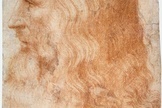 [image error]
[image error]
 A portrait of Leonardo da Vinci created by Francesco Melzi during Leonardo’s lifetime.
A portrait of Leonardo da Vinci created by Francesco Melzi during Leonardo’s lifetime.
Credit: Image in public domain, courtesy WikimediaView full size imageDuffin compared the engraving with a portrait of da Vinci drawn by Francesco Melzi, "who joined the 54-year-old Leonardo's household as an assistant in 1506 and eventually became his principal heir," Duffin wrote.
as an assistant in 1506 and eventually became his principal heir," Duffin wrote.
"Melzi's portrait shows a man with a beard and long curls, and the very slight bump in his nose and the ridge above the brow are an excellent match for the long-haired, bearded [man] in the Marcantonio engraving."
Most telling is the instrument the man in the engraving is playing. Duffin identified it as a lira da braccio, a bowed string instrument that da Vinci is known to have played.
In 1550, a few decades after da Vinci's death, a historian named Giorgio Vasari wrote of da Vinci's great musical skill. In 1494, "Leonardo was led in great repute to the Duke of Milan, who took much delight in the sound of the lira, so that he might play it," Vasari wrote in his 1550 book "Le vite de' più eccellenti pittori, scultori, e architettori" (translated).
"And Leonardo brought with him that instrument which he had made with his own hands, in great part of silver, in order that the harmony might be of greater volume and more sonorous in tone, with which he surpassed all the musicians who had come together there to play," Vasari wrote. "Besides this, he was the best improviser in verse of his day."
of silver, in order that the harmony might be of greater volume and more sonorous in tone, with which he surpassed all the musicians who had come together there to play," Vasari wrote. "Besides this, he was the best improviser in verse of his day."
Problem with identification
If the engraving does indeed portray da Vinci, the question becomes how Marcantonio Raimondi met him.
"The problems are of time and place," Kemp wrote in the email. "Marcantonio was working in Bologna at this early stage of his career, and there is no obvious way they would have met."
At this stage, I would say that it is temptingly possible but unproven," Kemp added.
However, Duffin said the two men might have met in Milan in 1506-1507 during a production of "Orfeo,"an opera on the Orpheus myth. If this is the case, then Leonardo himself could have been playing Orpheus in the opera, Duffin said. Another possibility is that the two artists met in 1509, when Leonardo visited Florence. Or perhaps the two never met, and Marcantonio Raimondi used a portrait as a reference when engraving da Vinci's features, Duffin added.
"We do not know for certain whether Marcantonio crossed paths with Leonardo, but his engraving of 'Orpheus Charming the Animals' seems clearly to be an homage, intended to honor the musical skill of Leonardo da Vinci by depicting him with the instrument he was known to play incomparably, and which he shared with the greatest of all musicians."

 This engraving, created by Marcantonio Raimondi around 1505, may show Leonardo da Vinci playing an instrument called a lira da braccio. The man in the engraving was thought to be Orpheus, a musician in Greek mythology.
This engraving, created by Marcantonio Raimondi around 1505, may show Leonardo da Vinci playing an instrument called a lira da braccio. The man in the engraving was thought to be Orpheus, a musician in Greek mythology.Credit: Image courtesy Cleveland Museum of Art, 21.4 x 17.3 cm. Dudley P. Allen Fund
 1930.579 View full size image
1930.579 View full size imageA 500-year-old engraving may show Leonardo da Vinci playing a musical instrument called a lira da braccio. If verified, the engraving would represent just the third contemporary depiction of da Vinci (created while he was alive) still in existence.
An artist named Marcantonio Raimondi created the engraving in 1505. But only recently did Ross Duffin, a music professor at Case Western Reserve University in Cleveland, identify the man in the engraving as Leonardo da Vinci, publishing the findings in the magazine
 Cleveland Art.
Cleveland Art."This is serious and stands some chance of being right," said Martin Kemp, an emeritus professor of art history at Oxford University who has written extensively about da Vinci, but who was not involved in the new research. [5 Surprising Facts About Leonardo da Vinci's Life]
Is this Leonardo?
When the engraving entered the Cleveland Museum of Art's collection in 1930, scholars thought the man in it was Orpheus, a musician in Greek mythology who was said to be so talented he could charm animals with his music. As such, the engraving was dubbed "Orpheus Charming the Animals."
However, Duffin said he came to realize the man was unlikely to be Orpheus and more likely to be da Vinci taking on the role of Orpheus. During the Renaissance, "one thing that is extremely consistent is that Orpheus is shown as a clean-shaven youth, the young husband of the tragic Eurydice," wrote Duffin in the article
 .
.The man depicted in the engraving is in his "late middle age, with a beard and centrally partedhair with long curls," wrote Duffin, adding that da Vinci would've been in his early 50s when Marcantonio Raimondi created the image.
 [image error]
[image error]
 A portrait of Leonardo da Vinci created by Francesco Melzi during Leonardo’s lifetime.
A portrait of Leonardo da Vinci created by Francesco Melzi during Leonardo’s lifetime. Credit: Image in public domain, courtesy WikimediaView full size imageDuffin compared the engraving with a portrait of da Vinci drawn by Francesco Melzi, "who joined the 54-year-old Leonardo's household
 as an assistant in 1506 and eventually became his principal heir," Duffin wrote.
as an assistant in 1506 and eventually became his principal heir," Duffin wrote."Melzi's portrait shows a man with a beard and long curls, and the very slight bump in his nose and the ridge above the brow are an excellent match for the long-haired, bearded [man] in the Marcantonio engraving."
Most telling is the instrument the man in the engraving is playing. Duffin identified it as a lira da braccio, a bowed string instrument that da Vinci is known to have played.
In 1550, a few decades after da Vinci's death, a historian named Giorgio Vasari wrote of da Vinci's great musical skill. In 1494, "Leonardo was led in great repute to the Duke of Milan, who took much delight in the sound of the lira, so that he might play it," Vasari wrote in his 1550 book "Le vite de' più eccellenti pittori, scultori, e architettori" (translated).
"And Leonardo brought with him that instrument which he had made with his own hands, in great part
 of silver, in order that the harmony might be of greater volume and more sonorous in tone, with which he surpassed all the musicians who had come together there to play," Vasari wrote. "Besides this, he was the best improviser in verse of his day."
of silver, in order that the harmony might be of greater volume and more sonorous in tone, with which he surpassed all the musicians who had come together there to play," Vasari wrote. "Besides this, he was the best improviser in verse of his day."Problem with identification
If the engraving does indeed portray da Vinci, the question becomes how Marcantonio Raimondi met him.
"The problems are of time and place," Kemp wrote in the email. "Marcantonio was working in Bologna at this early stage of his career, and there is no obvious way they would have met."
At this stage, I would say that it is temptingly possible but unproven," Kemp added.
However, Duffin said the two men might have met in Milan in 1506-1507 during a production of "Orfeo,"an opera on the Orpheus myth. If this is the case, then Leonardo himself could have been playing Orpheus in the opera, Duffin said. Another possibility is that the two artists met in 1509, when Leonardo visited Florence. Or perhaps the two never met, and Marcantonio Raimondi used a portrait as a reference when engraving da Vinci's features, Duffin added.
"We do not know for certain whether Marcantonio crossed paths with Leonardo, but his engraving of 'Orpheus Charming the Animals' seems clearly to be an homage, intended to honor the musical skill of Leonardo da Vinci by depicting him with the instrument he was known to play incomparably, and which he shared with the greatest of all musicians."
Published on June 03, 2015 07:44



